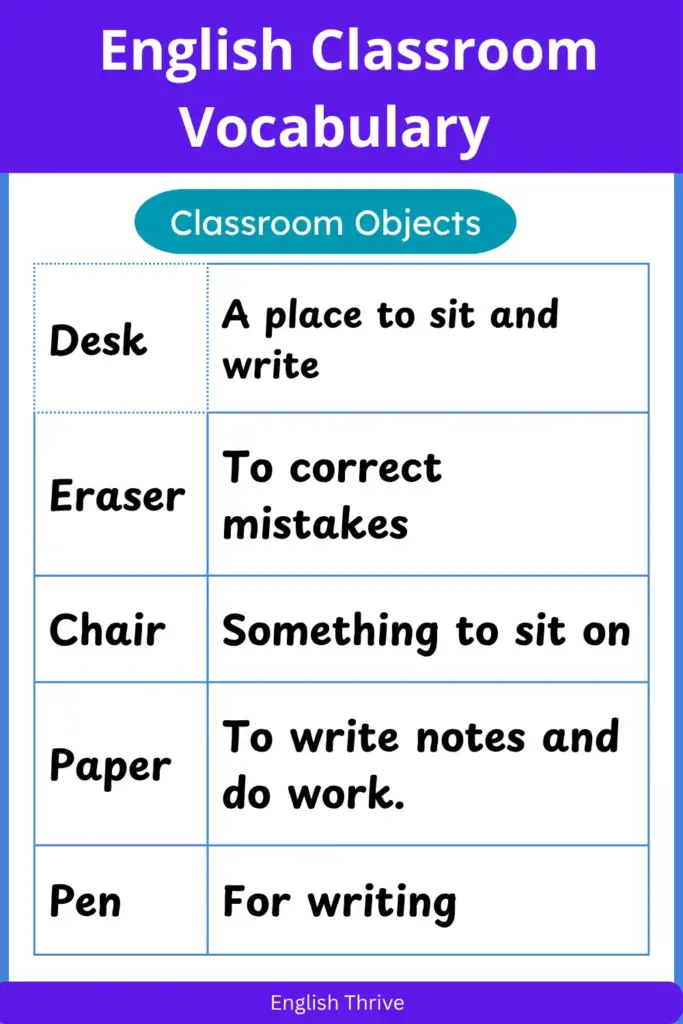Do you get lost when your teacher says a new word? Do you wonder what to call things in your classroom? Learning school words is fun and easy.
This guide shows you objects, actions, people, and rules at school. You will master English classroom vocabulary here.
Contents
ToggleClassroom Objects
Here are the main things you will see in a classroom.
- Desk—A place to sit and write.
- Chair—Something to sit on.
- Book / Textbook – For reading and learning.
- Notebook / Paper – To write notes and do work.
- Pen / Pencil – For writing.
- Eraser – To correct mistakes.
- Ruler – To measure or draw straight lines.
- Scissors/Glue – For cutting and sticking in projects.
- Backpack / School Bag – To carry your stuff.
- Clock—Shows the time.
- Whiteboard / Blackboard – Where the teacher writes.
- Marker/Chalk—To write on the board.
- Computer/Laptop—For research or schoolwork.
- Pencil Sharpener – Keeps pencils sharp.
- Calculator—for math problems.
- Highlighter – To mark important points.
- Binder/Folder—To organize papers.
- Crayons / Paints / Brush – For coloring and art.
- Globe/Map—To learn about the world.
- Flashcards—to remember words or facts.
Classroom Actions
These are common things you do in class:
- Raise your hand—to ask or answer questions.
- Listen—pay attention to the teacher or classmates.
- Write/Draw—Put your ideas on paper.
- Read—Understand words in books or notes.
- Clean up—put things back where they belong.
- Follow directions—do what the teacher asks.
- Speak—answer questions or share ideas.
- Work in groups—learn with classmates.
People in the Classroom
Know the main people around you:
- Teacher – Leads the class and teaches.
- Student – Learns in the class.
- Classmates—Other students in your class.
- Principal/Staff—Help the school run smoothly.
Classroom Rules
These words help you understand what to do in class:
- Raise your hand—don’t shout; wait for your turn.
- Be quiet—listen and avoid disturbing others.
- Complete homework—finish your tasks at home.
- Respect classmates – Be kind and polite.
- Follow instructions—do what the teacher asks.
English Classroom Vocabulary Practice Exercise
Exercise 1 – Match the Word
| Desk | Tool for drawing circles |
| Eraser | 3D model of the Earth |
| Globe | Removes pencil marks |
| Flashcard | Furniture for writing and studying |
| Compass | Cards used for memorization |
Answers:
Desk → Furniture for writing and studying
Eraser → Removes pencil marks
Globe → 3D model of the Earth
Flashcards → Cards used for memorization
Compass → Tool for drawing circles
Exercise 2 – Fill in the Blanks
Use words from teacher, notebook, scissors, ruler, backpack
I wrote all my notes in my _______
The _______ explained the lesson clearly
I cut the paper with my _______
Measure the line using a _______
I carry my books in my _______
Answers:
Notebook
Teacher
Scissors
Ruler
Backpack
Exercise 3 – Make Sentences
Pick any five classroom words and create sentences. Example:
Pencil → I sharpened my pencil before starting the test.
Whiteboard: The teacher wrote the homework on the whiteboard.
Sticky Notes: I used sticky notes to mark important pages.
FAQs About English Classroom Vocabulary
1. What is classroom vocabulary for students?
Classroom vocabulary includes words used in the school environment, such as objects, people, actions, and rules. These words help students communicate and learn efficiently.
2. How can students learn classroom vocabulary faster?
Label classroom objects
Use flashcards
Practice in real situations
Play matching and memory games
Review words regularly
3. What are some examples of classroom vocabulary words?
Some examples include desk, chair, pencil, notebook, glue, teacher, student, raise your hand, listen, and read.
4. How can teachers teach classroom vocabulary effectively?
Display words with pictures
Use word walls or posters
Introduce a “Word of the Day.”
Encourage students to use words in sentences
Conduct interactive games
Conclusion
Learn classroom words to make studying easy. They help you talk in class and feel confident. Start with simple objects, actions, people, and rules. Then practice by matching words, filling blanks, or making short sentences.
Get our free Classroom Vocabulary PDF to practice. You can also make flashcards to learn fast.


